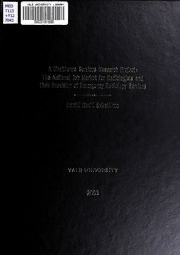
A healthcare services research project : the national job market for radiologists and their provision of emergency radiology services PDF
Preview A healthcare services research project : the national job market for radiologists and their provision of emergency radiology services
CUSHING/WHITNEY MEDICAL LIBRARY Digitized by the Internet Archive in 2017 with funding from Arcadia Fund https://archive.org/details/healthcareservicOOsake A Healthcare Services Research Project: The National Job Market for Radiologists and Their Provision of Emergency Radiology Services A Thesis Submitted to the Yale University School of Medicine In Partial Fulfillment of the Requirements for the Degree of Doctor of Medicine by Daniel David Saketkhoo Candidate for Joint MD/MBA degree 2003 VALE MEDICAL LIBRARY, AUG 1 1 2003 Abstract A HEALTHCARE SERVICES RESEARCH PROJECT: THE NATIONAL JOB MARKET FOR RADIOLOGISTS AND THEIR PROVISION OF EMERGENCY RADIOLOGY SERVICES. Daniel D. Saketkhoo, Anne M. Covey, Jonathan H. Sunshine, and Howard P. Forman. Department of Diagnostic Radiology, Yale University School of Medicine, New Haven, CT. Purpose is to present the most recent data on the nationwide diagnostic radiology job market using a help-wanted index and to investigate the provision of emergency radiology services. 1) All diagnostic radiology positions advertised in the American Journal of Roentgenology’ and Radiology between January 2000 and December 2002 were coded by practice type, geographic location, and subspecialty and were compared with previously published results from 1991 through 1999. 2) A telephone questionnaire asking about daytime image interpretation duties, night-time radiology coverage patterns, and radiologist staffing needs was administered to representatives of 97 private, community hospital emergency departments. From January 1999 through December 2002, 20,424 positions were advertised for diagnostic radiologists, representing a 287% increase as compared to the previous four-year period. The 12-month rolling average of job advertisements peaked in February 2002 (at 488 ads) and decreased rapidly to 432 in December 2002, a level not seen since August 2000. The proportion of academic advertisements has increased steadily during the past four years, from 34.0% in 1999 to 42.7% in 2002. A statistically significant relative increase in advertisements was noted in the Midwest. Statistically significant relative increases were also observed for the subspecialties of abdominal radiology, mammography, neuroradiology, pediatric radiology, chest radiology, and nuclear medicine; while statistically significant decreases were seen in general and vascular/interventional positions. Although relative demand for emergency radiologists has decreased, 23.7% of emergency departments surveyed reported shortages in emergency radiologist staffing. Radiologists perform daytime primary interpretation of plain films at 40.2% of these departments, CT scans at 93.8%, and sonograms at 93.1%. During the night-time, 8.2% of these departments possess no radiology coverge, 82.4% utilize teleradiology coverage in some form, and 9.3% employ m- house, rotating, “non-ER-dedicated” radiologists. Demand for radiologists has halted its multi-year ascent since Fall 2001. In addition, there is great variation in the provision of imaging interpretation throughout the nation, independent of emergency department size, location, and trauma center designation. Current policy should be directed toward training radiologists for areas of greatest need and developing standards for imaging interpretation across all subspecialties, including emergency radiology.
